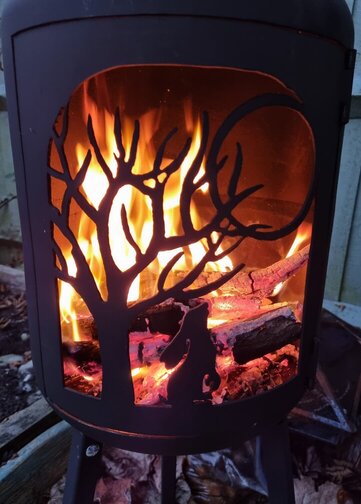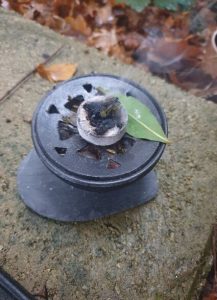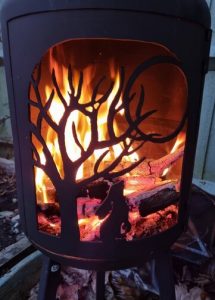Funeral Rites and Fire

The flame has long been a symbolic element of funeral rites, lit to guide the way from this life to another and to represent the light that someone has brought to this life.
We light candles to create a gentle ambience and to provide suffused light in the dying room, or provide a battery version where Oxygen canisters inhabit the same space! Flames are lit to guide those from the other realms who come to accompany the soul of those who are in transition. We may craft our own candles in sacred space particularly for the dying person, infusing oils and herbs to assist in the care and light the flame with prayer and intention.
Irish Travellers will keep a vigil and candles are lit near the bed of the dying person to light the way to the after-life. Candles are kept illuminated until after the funeral. In the Irish community it is believed that ‘God now lights the heavens to them” and the travellers “…like to keep candles and lights at the grave side and many now keep eternity candles which they like to keep lit at all times.” See ‘Cemetery Culture and Traditions‘ on gypsy-traveller.org
 Incense also has a central place in funeral ceremonies from the Catholic church to the druidic woodland burial. Incense is burned for cleaning and purification, for protection and transition.
Incense also has a central place in funeral ceremonies from the Catholic church to the druidic woodland burial. Incense is burned for cleaning and purification, for protection and transition.
In a funeral service, candles are often lit and a particular candle may be extinguished as part of a ritual of the ending of an earthly life and fires are used as a gathering focal point and a place for ritual in outdoor ceremonies.
And so, the element of fire is inextricably linked with the dying room, the vigil and the funeral. I am lighting a candle tonight as I write the ceremony for a lady described by her family as ‘eternally Spring’. She was described as being a ‘bright light’ and there will be a lot of candles at her ceremony!
“… in Mexico that is the tradition, that when someone you love dies you make a fire and you sit with the fire and let it burn all night. You keep feeding it, you gather around it, and you talk about the person who died. It’s a way to comfort one another as you light a path for the soul that has been called away.” Druidry.org
 I have many Order of Service booklets and printouts of ceremony wording for the funerals that I conduct. As a ritual to close my connection with those that I have spoken for, I call in the directions and ask for the support and presence of Cerridwen, my Goddess of Transformation; I create a fire and ceremonially burn the papers, speaking their names, sending my love and blessings to them and asking all those that guide and support them, to envelop them in their care.
I have many Order of Service booklets and printouts of ceremony wording for the funerals that I conduct. As a ritual to close my connection with those that I have spoken for, I call in the directions and ask for the support and presence of Cerridwen, my Goddess of Transformation; I create a fire and ceremonially burn the papers, speaking their names, sending my love and blessings to them and asking all those that guide and support them, to envelop them in their care.
The fire or candles in our home offer an opportunity for contemplation and reflection. The Canadian Ojibwe people have a particular custom with the fires in their homes and the use of flame as a guide for the spirit or soul.
“Upon death, the corpse is washed, groomed, dressed well and wrapped in birch bark before the burial. The family of the deceased will continuously burn a fire in their home for 5 days; until the body is buried. During the time of mourning (the first 4 days), food and tobacco are offered to the spirit and birch bark matches are placed in the coffin to ask the creator to light the spirit’s path to Gaagige Minawaanigozigiwining (the land of everlasting happiness).” See ‘Death: Ojibwe Traditions and Beliefs’
And of course, fire is a great transmuter of energy following death. In many traditions the pyre, an immensely hot outdoor construction, is built to cremate the body – the ultimate purification. In the UK the pyre is not legal, although there are some attempts by Hindus and Sikhs who are lobbying for open-air cremation on funeral pyres to bring this into the UK legislation as an alternative to the crematoria that provide purpose built, mechanical devices.
“Most Hindus are cremated. In Vedic ritual, fire (often seen as the fire god, Agni) is the means by which things are moved from the realm of mortals to the realm of the gods and this is true of the human body as well.”
“In the UK, most Hindus use the local crematorium. Tradition dictates, however, that the oldest son of the deceased should be the last person to touch the coffin and so Hindus may ask to be allowed to charge the cremator.” religionmediacentre.org.uk/factsheets/death-funeral-rituals-in-world-religions/
In the UK a witnessed cremation is available for those who wish to be present as the body enters the cremator although this tends to be utilised by those for whom their faith requires this.
Many will opt for the purification and transmutation of their earthly body by fire through cremation. The transformation from the physical Merkabah in which our souls travel through this life, to ashes, is a return to the elements, a literal reduction in the space that our bodies inhabited in life. It is the spark of our soul, our spirit, our consciousness that soars onwards and has no need of the physical. But don’t get me started on the environmental impact of cremated remains or the ‘green’ urns where you can grow a tree on the pot of ashes!
Perhaps you could light a candle for someone that you know is nearing the end of life or has passed into the line of ancestors. Light it and sit with it to send your love and blessings…
Sarah Weller
Anneva – Priestess of Cerridwen

I am blessed to work within my community as an end of life doula, a funeral ceremonialist/celebrant and as an undertaker working from my little farm- based funeral home – The Potager.
Sarah Weller PL.Dip.ST (BAST) Dip. GST (BAST)
sarah@naturalhomefunerals.co.uk
Really interesting, thank you Sarah
Thank you, Sarah! What a beautiful way to usher in the transformation offered by death of our human vessels. I appreciate learning about these ways to honor the transition journey. Your gift is mighty. I wish I would have known someone like you when my husband passed unexpectedly. I was too grief stricken to think of much of anything except the huge and painful loss. What beauty you bring!
In gratitude,
Connie Dewees-Gilger